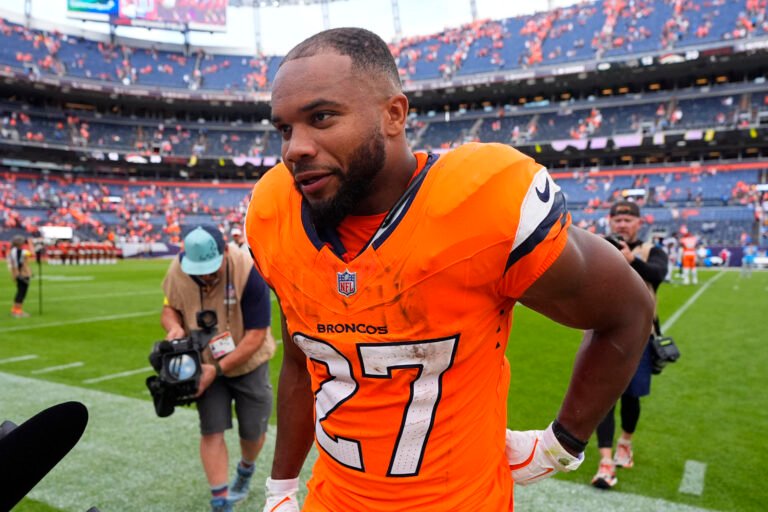The first round of the NFL Draft brought excitement and surprises, but it also led to significant shifts in the fantasy football landscape. Several players saw their value take a hit due to landing spots that complicate their immediate and long-term fantasy outlooks. The draft’s impact was felt across multiple positions, from running backs like Omarion Hampton and Najee Harris to wide receivers like Jalen McMillan. In this article, we’ll break down the fantasy football fallers after round 1, highlighting the players whose value may have been dimmed following their new team’s decisions.
Jalen McMillan and Chris Godwin
The Buccaneers’ wide receiver room is poised for an intriguing transition after the decision to draft Emeka Egbuka in the first round. Egbuka is a savvy slot receiver who is poised to be a good player in the NFL, but the team already re-signed Chris Godwin to a big extension this offseason, who is primarily a slot receiver. They also still have Mike Evans and Jalen McMillan, both had multiple WR1 performances last season as well. The Buccaneers now have potentially the deepest receiver room in the NFL, but for fantasy, it might not be the best thing.
Out of all of the receivers, I am confident that Mike Evans won’t see a dip in production from this move, as we have seen how consistent the future first ballot Hall of Famer has been his entire career. As for Chris Godwin and Jalen McMillan, I am worried about their value this season. McMillan is the biggest faller and becomes the 4th option on this offense and is no longer a sneaky pick at the end of drafts.
As for Chris Godwin, the move indicates that he might not be recovering well from his injuries, and the Buccaneers needed to add another receiver in the slot because of it. Godwin falls from a WR2 to WR3 territory with the pick of Egbuka until we hear positive news about his injury situation.
Omarion Hampton and Najee Harris
Both Omarion Hampton and Najee Harris have experienced significant declines in their fantasy football value, primarily due to their landing spots. Hampton’s arrival with the Los Angeles Chargers introduces immediate uncertainty in the backfield, where he’ll compete for carries with Najee Harris. Both are very similar in style—hard-nosed, between-the-tackles runners without substantial receiving upside.
This lack of receiving involvement severely limits their fantasy potential, especially in a system that doesn’t heavily target running backs in the passing game. With the possibility of a timeshare emerging, neither player is expected to provide the kind of volume needed to sustain strong fantasy production. In redraft leagues, Harris’s value drops to a low-end RB2, while Hampton could be a mid-tier RB3 with high upside, depending on how the season unfolds.

Tyler Warren
Many had Tyler Warren pegged as the first tight end off the board. Instead, he lands in Indy as TE2 behind Colson Loveland, drafted earlier by the Bears. Add in the fact that he now has Anthony Richardson or Daniel Jones throwing him the ball — two QBs not exactly known for supporting fantasy tight ends — and the situation goes from bad to worse.
Warren was one of the top prospects coming out of the draft, but with the current situation at quarterback, his value in his first few seasons will be touchdown-dependent. The Colts are likely to deploy a run-heavy scheme with Richardson and Jonathan Taylor leaving Warren to fight for more minimal targets with other pass catchers in the Colts’ offense. Warren falls from a sure-fire TE1 early-season ADP to a high-end TE2 heading into next year.
Shedeur Sanders
If you told us in September that Shedeur Sanders wouldn’t go in the first round, we’d have laughed. But here we are. Despite buzz from major media outlets, the NFL passed on Sanders again and again, and even QB-needy teams like the Giants traded back without selecting him. This suggests not many teams believe the tape is good enough to invest high draft capital in him with the baggage he comes with.
Sanders has the tools — arm talent, pocket presence — but also the red flags. He needs a clean pocket and an above-average offensive line to thrive. That’s not guaranteed wherever he ends up now. In dynasty formats, his stock takes a major hit as draft capital evaporates. And for redraft? He’s completely off the radar.
Cole Kmet
Cole Kmet was inconsistent in 2024 and will now take a complete backseat to new first-round pick Colston Loveland. Kmet’s value was intriguing before the draft filling into the LaPorta role within this offense and having sneaky upside. We will never get to see this come to fruition, as the team decided to go in a different direction, shifting Kmet to the 2nd-best tight end on the team. Kmet is not worth taking a look at in redraft anymore after the roster shakeup.




